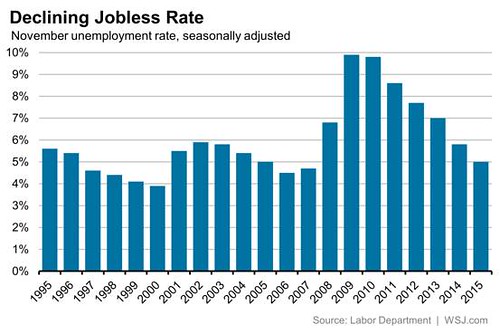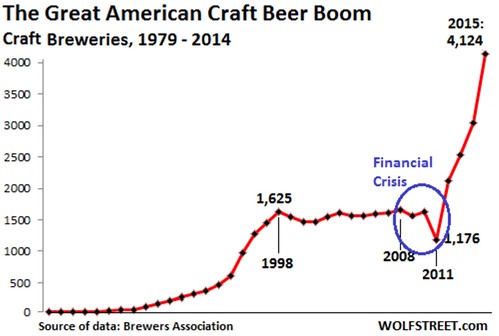December 2015's unemployment numbers are out, and ...
The U.S. economy finished the year with a red-hot hiring spree, adding 292,000 new jobs as the unemployment rate held steady at 5 percent, according to new government data released Friday morning. In all, the nation added 2.65 million jobs in 2015, the second-best year for hiring since 1999 and one that improved markedly in the last quarter. The economy added an average of 284,000 new monthly positions between October and December; in the first three-quarters of the year, the monthly pace was 200,000.
Keeping that in mind, let's look at a few 'craft' brewery numbers from 1995 forward.
From 2000 to 2005, the number of 'craft breweries decreased, from 1,566 to 1,447, this despite increasing employment numbers. This slowdown —which the Wall Street Journal infamously decreed as the sign of the demise of the microbrew' fad— actually had begun a few years earlier, when the rate of 'craft' brewery growth fell from 58% in 1995 to only 2% in 1997. A 'dilettante' investor boom in 'craft' beer fizzled as a lot of poorly made beer made it to shelf and bartop.
Modest brewery growth returned in 2006, with an uptick from 1,460 breweries that year to 1,813 in 2010, accounting for 9,951,956 barrels of beer produced in the U.S. The next year, in 2011, the same year that unemployment began to decrease as the aftereffects of the Great Recession were waning, the Great 'Craft' Beer Explosion began in earnest.
Since 2011, the national unemployment rate has decreased from 8.5% to 5%. At the same time, the number of breweries —most of which are 'craft' (producing fewer than 6 million barrels of beer per year)— has increased by 252%, from a count of 2,033 to more than 4,144 in 2015, a record number for U.S. breweries (surpassing the previous historic high of 4,131, set in 1873) and certain to be itself surpassed in 2016.
These 'craft' breweries produced 21,940,000 barrels of beer in 2014 (2015 numbers are yet to be tabulated), employing more than 115,000 people. Furthermore, according to the [U.S.] Brewers Association, 96% of those breweries produced fewer than 15,000 barrels of beer per year. The inefficiency of small-scale suggests that more people are employed by that large number of smaller breweries than by only a few larger breweries producing the same.*
Economists place the timeline of the Great Recession over nineteen months, from December 2007 through June 2009. 'Craft' breweries have proliferated since its end. Coincidence?
-----more-----
- * According to The Drink Nation, the craft brewing industry, on average, employs fifty-nine employees per one barrel of beer produced versus AB InBev at one employee per barrel.
- The slug for this post paraphrases "Silent Cal" Calvin Coolidge, 30th President of the United States, who said, of the Great Depression: "When more and more people are thrown out of work, unemployment results."
- The historical brewery numbers are from the [U.S.] Brewers Association: here and here.
- The graphic above, posted to Business Insider, has slightly different data points than the Brewers Association, even though Business Insider cites the BA as its source.
- The U.S. Labor Department's economic report was not all tea and crumpets. The Washington Post reports:
The jobs data from December showed a labor market that is steadily growing but providing only modest wage gains to employees. Last month the average hourly wage fell by a penny, to $25.24. Since one year ago, wages are up 2.5 percent — below the pace from before the Great Recession, but a tick above the crawling pace maintained throughout much of the recovery. [...] Some economists say that a massive shadow workforce still lingers on the sideline, a group that is not currently looking for jobs and not counted in unemployment figures. The share of Americans holding jobs or looking for work has fallen steadily for 15 years, and in December, the so-called labor force participation rate was little changed, at 62.6 percent.
- For more from YFGF:
- Follow on Twitter: @Cizauskas.
- Like on Facebook: YoursForGoodFermentables.
- Follow on Flickr: Cizauskas.
- Follow on Instagram: @tcizauskas.











No comments:
Post a Comment
Comment here ...